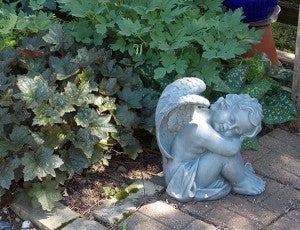What to plant in shadier areas
Published 9:00 am Sunday, April 27, 2014
Serendipity Garden by Carol Hegel Lang
Most gardeners are probably faced with some shady nooks and crannies in their gardens, and I, too, happen to have them. When I first started gardening over 35 years ago, that is all I had because a gigantic oak tree shaded my entire yard. Now that tree is gone and I only have smaller shady spaces to garden in.
So often when we have shady areas the only plant we can think of is hostas to fill in the area, but over the years we have seen more and more wonderful plants to fill out these gardens. In the photo you will see coral bells, or heuchera, pulmonaria and bleeding hearts, all of which add both color and texture to this little nook. The flowers on coral bells are not that impressive, but they do add even more texture to the garden all season as when they have finished blooming. I leave them on the plants until fall when I cut everything back.
The pulmonaira that I have is Mrs. Moon. It produces a spring blooming bud that is blue and then opens to a lovely pink color. The spotted leaves really are what makes this plant attractive all season because when the small flowers are done blooming I cut them off down to the leaves to neaten up the plant. This little garden is under a blue spruce that has been trimmed up to about 8 feet and later in the afternoon this nook gets the west facing hot sun so it needs to be watered daily to keep them looking good.
In the back gardens along the west fence they have filtered sunlight from early morning until early afternoon when the neighbor’s maple trees shade them. This is a great location to grow fuchsia in hanging baskets and in containers on the ground. I have pink New Guinea impatiens, and blue arrows juncus and snow princess lobularia. This is a colorful area all summer and a cool place to sit and enjoy the garden on one of the many benches located throughout the gardens.
The front garden has early morning sun, and by noon the neighbor’s oak trees give it filtered light, and then my very tall white pine shades it the rest of the day. In spring I have a Miss Kim lilac adding color and fragrance, purple alliums and purple irises along with white bleeding hearts, making this garden really stand out as you walk by on the sidewalk.
Yes, there are areas that don’t receive as much light so I have planted many variegated hostas under the white pine to lighten up this area. As the summer progresses the different types of lilies, Oriental, Asiatic and trumpet, fill the space with color and fragrance where they receive the strong morning sunlight. I also have a shepherd’s hook with fuchsia to add even more color.
I would like to add lupines, ligularia and maybe another tall garden phlox for more color in this garden.
There is space to plant flowers in containers toward the front of this garden, and I have found that Victoria blue salvia does quite well and so does browalia, which is very difficult to find at garden centers anymore.
When you have filtered or partial shade it would be the ideal location for many of the new smaller varieties of hydrangeas on the market.
Ferns love shade, and I have a maiden fern in this garden with its lacy fronds that sway with the breeze.
I’m planning to add a Japanese painted fern this year as well as lady in red with its vibrant red stalks.
Ferns really add texture as well as motion to the garden. If you are lacking color then add astilbe that takes partial shade or astrantia. Both come in several bright colors. I love to plant violas in a bright container that contrasts with their color to give me a pop of color. Torenia is another annual with pretty flowers or, if you have lots of space, try elephants ears that you plant as a tuber for height and excitement.
So embrace those shady areas, and use color and texture for excitement.





